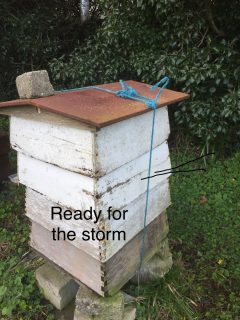 Well, what a windy few days we’ve had with Dudley, Eunice and Franklin. Yet again, though, we’ve escaped lightly here on the south coast, but since I did not know what was coming, in terms of the severity of the winds, I tied down my more susceptible hives.
Well, what a windy few days we’ve had with Dudley, Eunice and Franklin. Yet again, though, we’ve escaped lightly here on the south coast, but since I did not know what was coming, in terms of the severity of the winds, I tied down my more susceptible hives.
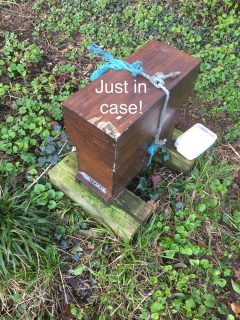 This would mean that if they did get blown over they at least would be held together and the bees would not be exposed to the ravages of any storm. I still have bees in a bait hive in one of the trees in my home apiary, so they were likely to be the most exposed to any winds we might have, so I double strapped that hive and then tied it to the trunk of the tree.
This would mean that if they did get blown over they at least would be held together and the bees would not be exposed to the ravages of any storm. I still have bees in a bait hive in one of the trees in my home apiary, so they were likely to be the most exposed to any winds we might have, so I double strapped that hive and then tied it to the trunk of the tree.
So far, this seems to have done the job, thank Goodness!
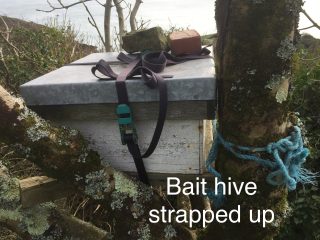 Despite my preparations, though, one of my poly hives was tilted off its stand at a precarious angle and the adjacent hive had its roof blown partly off – there must have been a strong gust from a very specific direction for the other hives not to have been affected.
Despite my preparations, though, one of my poly hives was tilted off its stand at a precarious angle and the adjacent hive had its roof blown partly off – there must have been a strong gust from a very specific direction for the other hives not to have been affected.
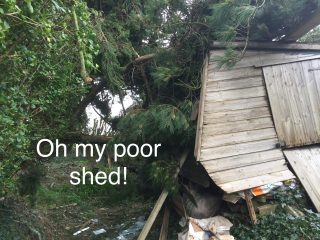 More than can be said for one of my bee-sheds, however, which has had a large tree blown over onto it! The shed was on its last legs anyway, luckily, so this will prompt me to do something about clearing it out and taking it down.
More than can be said for one of my bee-sheds, however, which has had a large tree blown over onto it! The shed was on its last legs anyway, luckily, so this will prompt me to do something about clearing it out and taking it down.
My out-apiaries also experienced the gales, one of the hives having its roof blown away, exposing the bees feed-hole in the crown-board, to the winds. Luckily, I received a phone call to let me know and on arriving at the site I could see the bees were totally 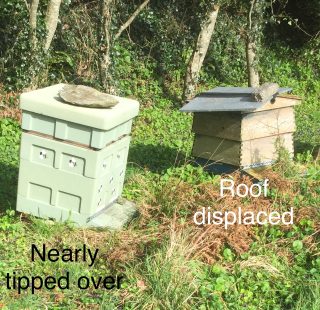 unphased by this and were tucking in to their winter fondant as if everything was quite normal. Unfortunately, two other colonies had succumbed to queen loss and the hives were empty of bees, though, as I think I’ve said before, it is an exposed site so perhaps not too surprising. However, for those colonies at this out-apiary, the future looks rosy! There are signs of winter- sown rape coming into flower, so they will be well provided for in a few weeks’ time.
unphased by this and were tucking in to their winter fondant as if everything was quite normal. Unfortunately, two other colonies had succumbed to queen loss and the hives were empty of bees, though, as I think I’ve said before, it is an exposed site so perhaps not too surprising. However, for those colonies at this out-apiary, the future looks rosy! There are signs of winter- sown rape coming into flower, so they will be well provided for in a few weeks’ time.

Storms apart, the bees are increasing the amount of flying they are doing now, despite the wind and the sometimes quite low temperatures (8°C on this occasion!) and are out collecting pollen at every opportunity, with the survivor colonies all looking quite strong.
I just need to keep on top of their feeding requirements until the blackthorn is in flower. Some colonies are also wolfing down the sugar candy I am placing on the crown-boards, so the queens in those colonies must be increasing their laying quite rapidly. I can’t wait for the season to begin again.
For those who treat their bees for Varroa, an interesting project is currently underway in the US. A mushroom farmer and a scientist have created a beehive containing fungi that might just be the key to saving the imperiled honey bee from the predations of Varroa. Farmer Paul Stamets started thinking there might be a possible relationship between his crop of mushrooms and bee health after he watched the insects in his garden eating the root-like filaments called mycelium.
With bee populations collapsing since the 1980s and threatening world food supplies, scientists are groping for answers. At least 61 culprits – from viruses to pesticides – are to blame, but one of the biggest threats is a mite that exploded on the scene in 1987, viz Varroa.
The lifespan of the Varroa mite is so short, it has been able to evolve and develop resistance to pesticides that have been previously able to control it, but now Stamets has launched a research project that will eventually allow him to show that compounds in certain mushrooms can boost a bee’s immune system.
Research so far has shown that mushrooms on certain trees frequented by bees in the Pacific Northwest actually can protect the bees from viruses. T he mushroom nutrients also help them break down harmful pesticides and chemicals. The next step was to go after the mites.
Stamets teamed up with Washington State University entomologist — and beekeeper — Steve Sheppard, and the two have been exploring the idea that mushrooms might be able to protect bees from the little parasites.
After identifying a species of mushroom — Metarhizium anisopliae — that appears to kill the Varroa mites without hurting the bees, they are now testing beehives that contain the mushrooms that would create natural protection for the bees. Stamets and Sheppard are dropping chunks of cardboard dusted with finely ground powder from the mushroom into standard bee boxes. As the bees rip out the clutter to better organize their hives, they cover themselves in the potentially mite-killing compounds.
They are working with one of Washington state’s largest beekeeping operations to see if their plan to build beehives from mushrooms will protect the vital pollinators. “Nature leads us to solutions if we connect the dots, are open minded and think creatively,” Stamets says. “We need to be innovative to create solutions that help tilt the balance to help bees, and ultimately us”.
That’s all for now folks. Let’s hope for a quieter month ahead.
Colin Rees colinbeeman@aol.com 07939 971104 01872 501313

